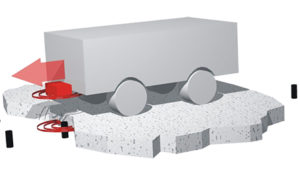

Transponder Systems use RFID (Radio Frequency Identification) technology to determine the position of a vehicle. One-dimensional systems are used to establish the location of a guided vehicle along its path e.g. a rail mounted crane, train or a wire guided AGV (Automated guided vehicle). Two-dimensional systems allow self guidance or auto steering of vehicles e.g. AGVs or “driverless” trucks.
FUNCTIONALITY:
Transponders are passive electronic devices receiving and sending radio signals without using a battery or power connection. They are usually located along the path of the vehicle. If the vehicle approaches, the following steps take place:
- The vehicle’s antenna constantly sends low strength radio signals.
- When the vehicle approaches a transponder, the vehicle’s radio signal (electromagnetic field) induces electric power at the transponder, the transponder “wakes up”.
- The now energized transponder starts sending or reflecting a return signal. The signal contains a coded message that allows the vehicle’s antenna/reader to identify the transponder.
- The vehicle antenna receives the transponder’s message. It determines its general position as “near the identified transponder”.
- When the vehicle antenna passes over the transponder, an additional pulse signal is created by the reader, allowing the vehicle to determine its exact position at that time.
- More advanced vehicle antennas/readers allow the vehicle to determine its precise position in relation to the energized transponder in driving direction X and side deviation from the antenna middle line Y.
ADVANTAGES AND CHALLENGES:
- RFID is a reliable and safe technology. GOETTING components are used to locate passenger vehicles at speeds exceeding 55 mph.
- Performance of this guidance system is not affected by adverse light conditions, including operation at night, or by fog, airborne dust, lint, fluid spraying, bright daylight and welding.
- Performance is also not affected by objects on the path or in the environment like debris, spills, snow, ice, standing water, fluids, floor irregularities etc. (exception: large steel plates).
- Arranging transponders in a field (matrix) allows directing guided vehicles freely within an area. They can adapt to new floor layouts by software changes only, and can introduce “free-flow” dynamic traffic regulation between several AGVs.
- The installation of “ID-nail” type transponders is usually done by drilling, then inserting transponder, and closing the hole with resin. This is generally less expensive than guide wire installation, while also providing similar system reliability. In some cases, surface-mounting is an option (e.g. little other traffic).
- Transponders are passive and do not require continuous additional power: no cable connection or battery is needed.
- Transponder code is read multiple times while the vehicle passes, allowing error checking.
- Large metal plates (e.g. in steel mill), powerful high-frequency power systems (e.g. from frequency converter) or certain types of concrete re-bar may have a negative impact on system performance. CTS and GOETTING offer site evaluation services to determine the best solution for the environment and application.
